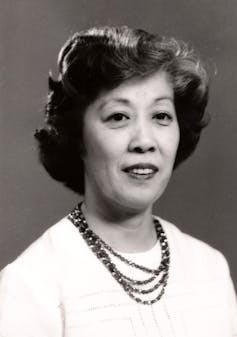
John Bergeron, McGill University
March 21 is World Down Syndrome Day. In 2011, the United Nations adopted a resolution to celebrate the lives of those with this once socially debilitating condition and the efforts of families and communities to increase the quality of life of those affected.
With the exception of sperm, egg and red blood cells, each cell in our body has two copies of each of 23 chromosomes. In Down syndrome, a third copy of chromosome 21 — known as trisomy 21 — is found in each cell. Hence, the Down Syndrome Day is marked on the 21st day of the third month of each year.
Although Down syndrome remains prevalent today in Canada, quality of life has become the key to management of the syndrome. Counselling programs for families with Down syndrome are in place across Canada.
International efforts to humanize this syndrome began in the 1960s, and written requests were made to the medical journal The Lancet by physicians as well as the grandson of the first person to describe the syndrome, British physician John Langdon Down. In 1965, a name change to Down syndrome was accepted by the World Health Organization.
At the time, there was widespread prejudice towards those afflicted and existing institutional practices were often barbaric. Journalist Catherine McKercher’s 2019 book, Shut Away: When Down Syndrome Was a Life Sentence, investigated what happened to her brother when he was institutionalized in 1961 with disastrous consequences.
A leading researcher

Although Down syndrome is the leading genetic cause of cognitive disability, little is known of the initial handful of Canadian researchers whose work contributed to the understanding of Down syndrome.
Through mentors that included the geneticist Norma Ford Walker and pathologist Bruce Chown, Canada’s Irene Ayako Uchida became a pioneer and health research leader in the field of genetics in her own right.
After training at the University of Wisconsin with geneticist Klaus Patau and cytogeneticist Eeva Therman, she returned to Canada to found the country’s first cytogenetics laboratory at the Children’s Hospital in Winnipeg to detect chromosomal abnormalities. Uchida was the first to identify the link between Down syndrome and exposure to X-ray radiation, with the chromosomal imbalance originating from either parent.
Memory connections
Down syndrome is accompanied by memory difficulties, and enormous progress has been made in learning more about memory through the work of Canadian researchers.
Read more: A memory pill? Cognitive neuroscience's contributions to the study of memory
McGill University psychologist Donald Hebb showed that the enhancement of synaptic connections in the brain led to long-term memory. His trainee Brenda Milner, who went on to found the field of neuropsychology, discovered that the hippocampus of the brain was the site for memory acquisition.
The mechanism for how memory acquisition happens was uncovered by McGill molecular biologist Nahum Sonenberg. With his trainee, Mauro Costa-Mattioli, they discovered that memory acquisition in mice occurs through signals that trigger the synthesis of new proteins. Sonenberg and Costa-Mattioli observed the consequences of the addition or removal of phosphate to one initiation factor needed to make proteins in the hippocampus.
This discovery was seized upon by molecular biologist and biochemist Peter Walter at the University of California San Francisco, an expert on the initiation factor that Sonenberg had discovered as the key to memory. Together, they discovered a potential memory drug, which Sonenberg showed enhanced memory in mice.
Recently, the discovery circle has been completed. Sonenberg’s former trainee Costa-Mattioli collaborated with Walter. They discovered that the memory drug ISRIB would reverse the memory defect in mouse models of Down syndrome.
The trajectory of discovery from basic science to the patient is a credible hope for Down syndrome. All of the basic science discoveries have stood the test of time and clinical trials are expected for drugs under development.
Research paths
For the memory breakthrough, open discovery research — where scientists follow their curiosity rather than a search for an answer or cure — led to the collaboration between Sonenberg and Walter. This research guided Sonenberg’s former trainee, Costa-Mattioli to uncover with Walter the mechanism that leads to the memory difficulties in Down syndrome. Coincidentally, they found that the same drug discovered by Sonenberg and Walter previously would also reverse the memory difficulty in the mouse model of Down syndrome.
It is the Sonenberg discovery that is unexpected. He is a molecular biologist who specializes in the machineries cells use to make proteins. He pioneered the field of “translational control.” This field explains the regulation of when, where and how proteins are made in each of our cells. Sonenberg discovered that this regulation was through protein synthesis initiation factors. He uncovered their importance not only in cancer, but also in autism spectrum disorder; studying memory was a logical next step. Sonenberg discovered the key “initiation factor” for new protein synthesis required for memory.
Supporting discovery
The same is not true in Canada. Sonenberg was selected as a health research leader for a Foundation Grant from the Canadian Institutes for Health Research. The program was terminated in 2019 with no alternative in place today for internationally competitive funding to our most talented.
For Down syndrome, open discovery research produced findings that have improved the quality of life of those affected by the condition.
John Bergeron gratefully acknowledges Kathleen Dickson as co-author.![]()
John Bergeron, Emeritus Robert Reford Professor and Professor of Medicine, McGill University
This article is republished from The Conversation under a Creative Commons license. Read the original article.

